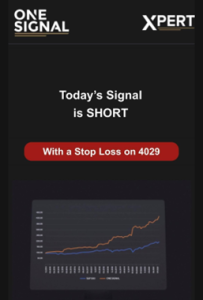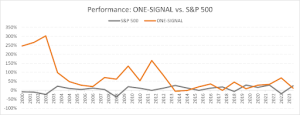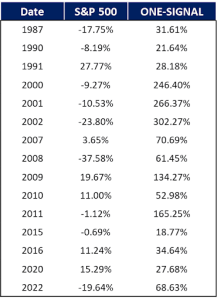In the relentless pursuit of outperforming the market, investors often find themselves grappling with a myriad of challenges when trying to figure out how to beat the S&P 500.
This article delves into the common hurdles faced by investors and unveils a clever strategy that has proven successful in navigating the complex landscape of financial markets. This strategy centres on eliminating noise in the market and focuses on consistency in trading and returns. Before diving into the strategies that can help you beat the S&P 500, it’s essential to understand how ONE-SIGNAL provides traders with real-time insights to optimize their investments.
Why Most Actively Managed Funds Are Falling Short
Funds that are actively managed, requiring an additional fee for a team of well-compensated fund managers to selectively choose stocks they believe will outperform, have, in reality, shown poorer performance compared to more cost-effective passive funds that merely mirror the nearest comparable index.
How to Beat the S&P 500
- Understand market indices and their movements.
- Utilise strategies like dollar-cost averaging and index funds.
- Consider the impact of market volatility and economic indicators.
In fact, over the past five years, almost 81% of large-cap actively managed US equity funds underperformed their benchmarks. This is due to a certain number of factors, including:
Fees and expenses:
Actively managed funds typically charge higher fees than passively managed index funds. These fees can erode returns, making it challenging for actively managed funds to outperform their benchmarks consistently.
Lack of consistency:
Successfully timing the market and picking winning stocks consistently is a challenging task. Even skilled fund managers may struggle to maintain a consistent track record of outperformance over time.
Overtrading:
Some active managers may engage in excessive trading, leading to higher transaction costs and potential tax implications. Overtrading can also result in a lack of discipline and a departure from a well-thought-out investment strategy.
Herd mentality:
Fund managers may succumb to herd mentality, following the crowd rather than making independent investment decisions. This can lead to crowded trades and increased risk when the market sentiment suddenly shifts.
Risk aversion:
Actively managed funds may be more inclined to adopt a conservative approach to avoid underperformance. This can result in a portfolio that closely mirrors the benchmark, making it challenging to outperform after accounting for fees.
The Investment Strategy to Beat The S&P 500
When faced with how to beat the S&P 500, the importance lies in maintaining clarity, enabling a focus on relevant information that directly impacts asset values.
Decluttering the Noise is Imperative
Eliminating unnecessary market noise is essential for investors to make well-informed decisions in the dynamic investment landscape.
Techniques for identifying and filtering out distractions involve leveraging comprehensive research, relying on reputable sources, and employing analytical tools. Disciplined risk management and a long-term investment perspective can also help sift through short-term fluctuations and noise.
By adopting these strategies, investors can navigate the market with a clearer understanding, avoiding unnecessary distractions and making more sound and strategic investment choices. This not only enhances the accuracy of decision-making but also contributes to building a resilient and sustainable investment portfolio that consistently beats the S&P 500. One of the most effective ways to filter out noise in the market is to have a systematic trading approach, which is applied in the same way every day.
How ONE-SIGNAL Helps Eliminate White Noise
This is what ONE-SIGNAL is about: helping traders establish a straightforward trading routine while eliminating the white noise in the market, which is always detrimental to trading profits.
ONE-SIGNAL was developed after numerous years of research on stock market bubbles and the behaviour of investors as individuals and in masses. The development of these bubbles is attributed to three psychological factors, being greed, envy, and speculation. Conversely, fear, lack of confidence, and disappointment will cause these bubbles to burst.
Based on this, Ara Yalmanian developed ONE-SIGNAL, a non-discretionary system that applies the contrarian investing approach using sentiment indicators. The algorithm systematically analyses market sentiment to recognize emotions associated with bubble formations and predicts subsequent movements.
We believe that sentiment indicators are the best metric to systematically and objectively analyse stock market behaviour and predict price movements in every phase of the market. This is based on years of proprietary research and successfully testing our findings in the markets. For traders looking to capitalize on short-term market movements, exploring swing trading strategies for S&P 500 stocks can be a great starting point.

How the ONE-SIGNAL Approach Creates An Effective Investment Strategy
Within our approach, we do not use:
- Fundamental analysis, to avoid valuation inaccuracies
- Technical analysis, to avoid self-fulfilling prophecies
- Common indicators, to avoid “trend following”
Due to our unique approach, the system pinpoints sentiment trends and follows them until the exaggeration phase, to then change direction strategically. We are the only trading signal software provider to purely rely on sentiment indicators. As a result, we promote a smarter trading technique and more efficient overall trading strategy, not paying attention to any of the market noise, such as earnings releases, macroeconomic indicators, or geopolitical events.
Despite how complicated a trading system is behind the scenes, the delivery must be simple and concise and include a risk management system.
That is why our trading signals are short, concise, and clear, with an integrated risk management system in the form of a stop loss. Every day, ONE-SIGNAL subscribers receive a LONG or SHORT trading signal, valid for one trading day.
With our offering, ONE-SIGNAL Xpert subscribers receive their trading signal 3 hours before the NYSE opening bell. Positions are entered at the NYSE opening bell and closed at the end of the trading day. This enables a systematic approach and allows individuals to establish a trading routine. Traders need only open their trades, go about their daily business, and close the trade at the end of the day. This systematic approach enables traders to build a trading routine, eliminate all noise in the market, and focus on wins that beat the S&P 500.
Our Results
Our results speak for themselves. For example, since 2010, the S&P 500 returned on average 11.44% per year, as opposed to ONE-SIGNAL, which returned 38.46% on average per year. The same applies for the period since 2020, where the S&P 500 returned on average 12.29% per year, and ONE-SIGNAL 35.16%.
Let’s have a look at a longer period.

ONE-SIGNAL excels in market downturns by employing a strategy that involves identifying and tracking market trends. The system strategically adjusts its direction before a reversal, anticipating market downturns and generating SHORT signals to capitalise on them. The system’s profitability during downturns is exemplified in the provided table.

Summary
In summary, investors grappling with the challenges of how to beat the S&P 500 can find a solution in ONE-SIGNAL’s clever strategy, which eliminates market noise through a focus on sentiment indicators and a systematic trading approach.
By avoiding common pitfalls like fundamental and technical analysis, ONE-SIGNAL has consistently beat the S&P 500 since 2010. Subscribers benefit from clear signals, fostering a smarter and more efficient trading strategy. The historical performance data, especially during market downturns, attests to the system’s reliability.
In conclusion, adopting this approach reinforces the potential for real earnings, making it crucial for investors to join ONE-SIGNAL. This platform not only distances itself from market noise but also provides accurate information, irrespective of market trends, offering a valuable tool for those seeking consistent and profitable results.

